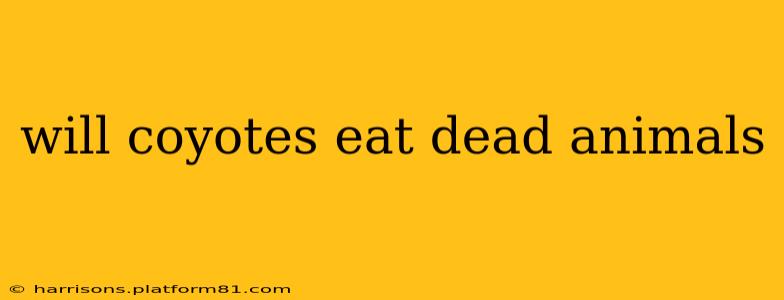Coyotes are highly adaptable and opportunistic carnivores, meaning their diet isn't limited to freshly hunted prey. The question, "Will coyotes eat dead animals?" is a resounding yes. Scavenging plays a significant role in their survival and contributes to their ability to thrive in diverse environments. Let's delve into the specifics of their scavenging behavior and address some common questions surrounding this aspect of their diet.
What Types of Dead Animals Do Coyotes Eat?
Coyotes are not picky eaters when it comes to carrion. Their scavenging behavior encompasses a broad range of dead animals, including:
- Deer: Roadkill deer are a common and readily available food source for coyotes, especially in areas with high deer populations.
- Rabbits and Hares: These smaller mammals are often preyed upon by coyotes, and their carcasses may also be consumed if found.
- Rodents: Mice, rats, and other rodents are a regular part of the coyote diet, both alive and dead.
- Birds: Dead birds, particularly those that have fallen prey to other predators or died of natural causes, are readily consumed.
- Livestock: While coyotes primarily hunt smaller livestock like sheep and poultry, they'll certainly scavenge carcasses if available.
- Domestic Pets: Sadly, coyotes have been known to scavenge the remains of unattended domestic pets.
How Do Coyotes Find Dead Animals?
Coyotes utilize a combination of senses to locate carcasses:
- Smell: Their acute sense of smell is paramount. They can detect the scent of decaying flesh from considerable distances.
- Sight: Coyotes have good eyesight and can spot carcasses, particularly in open areas.
- Sound: While less relied upon than smell and sight, sounds like struggling animals or the activity of other scavengers can lead them to a food source.
Do Coyotes Prefer Live Prey or Dead Animals?
While coyotes are adept hunters and prefer live prey, scavenging supplements their diet, especially during periods of food scarcity or when hunting proves challenging. The availability of carrion directly impacts how much they rely on scavenging. In areas with ample live prey, scavenging might be a smaller portion of their diet, but in harsher environments or during lean times, scavenging becomes crucial for survival.
Are There Any Risks Associated with Coyotes Eating Dead Animals?
Eating dead animals presents potential risks:
- Disease: Carrion can harbor diseases and parasites that could harm the coyote. However, coyotes have evolved some level of tolerance, though not immunity, to pathogens found in decaying flesh.
- Toxicity: If an animal died from poisoning, consuming its remains can be fatal for the coyote.
Can Coyotes Spread Disease Through Scavenging?
While coyotes are generally resilient to many diseases, they can potentially act as vectors for some pathogens. However, the risk of disease transmission from coyotes to humans due to their scavenging behavior is relatively low. Maintaining a safe distance and avoiding contact with wild animals is always advisable.
What Attracts Coyotes to Human Areas?
The presence of readily available food sources, including garbage, pet food, and even unsecured livestock, attracts coyotes to human-populated areas. This increases the likelihood of encounters and, unfortunately, may lead to incidents involving domestic animals. Proper waste disposal and responsible pet ownership are crucial in mitigating these risks.
In conclusion, coyotes are opportunistic omnivores that readily incorporate scavenging into their feeding strategies. While live prey is preferred, carrion plays a vital role in their survival, especially when resources are scarce. Understanding their scavenging behavior is crucial for coexistence and managing potential conflicts between coyotes and humans.
